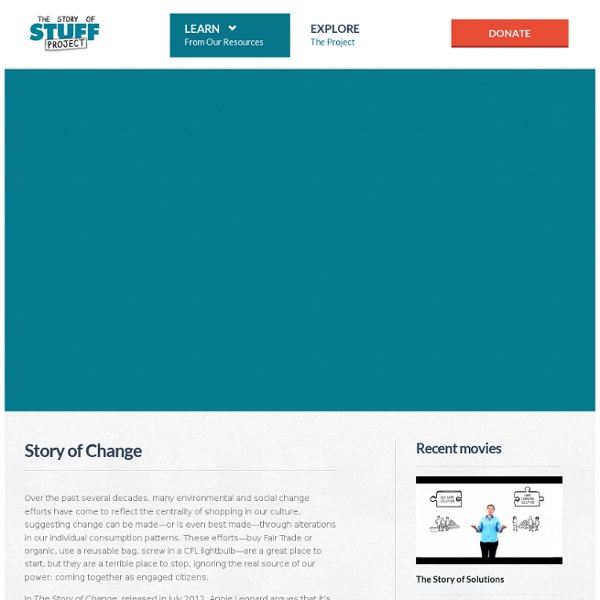Stellarium
Wissensmanufaktur - Herzlich willkommen bei der Wissensmanufaktur - Institut für Wirtschaftsforschung und Gesellschaftspolitik - Andreas Popp - Rico Albrecht
Suffizienz (Ökologie)
„Einer naturverträglichen Gesellschaft kann man in der Tat nur auf zwei Beinen näherkommen: durch eine intelligente Rationalisierung der Mittel wie durch eine kluge Beschränkung der Ziele. Mit anderen Worten: die „Effizienzrevolution“ bleibt richtungsblind, wenn sie nicht von einer „Suffizienzrevolution“ begleitet wird.“ „Die Suffizienz ist politisch ungleich heikler als die Effizienzfrage "Öko-Suffizienz" - Publikationen und Meldungen des Wuppertal Instituts für Klima, Umwelt, Energie GmbH.Bundesamt für Umwelt (Schweiz): Effizienz versus Suffizienz: Kluges Wachstum oder Genügsamkeit aus Einsicht? Wolfgang Sachs: Die vier E's: Merkposten für einen maß-vollen Wirtschaftsstil.
5 Ways to Create the Perfect World
Can there be such a thing as a perfect world? It is an ideal that many people think is unattainable. Surely, though, it is an ideal worth striving for. What is the worst that can happen if we fail to create the perfect world? What is a perfect world? Take steps towards creating your perfect world. What is your perfect world? To create a perfect world, it is going to take many people making small changes. So, what is your vision of a perfect world?
Business Model Creativity – Model smart, play tough!
Ökoeffizienz
Ökoeffizienz ist der Quotient aus dem wirtschaftlichen Wert eines Produktes und den durch den Herstellungsvorgang auf die Umwelt ausgeübten Auswirkungen, gemessen in einer geeigneten Einheit. Der Begriff wurde 1991 vom Wirtschaftsrat für nachhaltige Entwicklung (Business Council for Sustainable Development, heute World Business Council for Sustainable Development – WBCSD) in die Wirtschaftswelt eingeführt. Die Motivation dafür war, dass negative ökologische Wirkungen und die Ressourcenintensität über den gesamten Lebenszyklus (des Produktes) auf ein Niveau gebracht werden sollen, das mit den Tragfähigkeitsgrenzen der Erde vereinbar ist. Der Wirtschaftsrat für nachhaltige Entwicklung definiert Ökoeffizienz über die Formel: Ökoeffizienz = (Wirtschaftlicher Wert eines Produktes) / (Einfluss bzw. Dieses Konzept fordert die Maximierung des Wertes (utility) pro Einheit „Umweltbelastung“. Literatur[Bearbeiten] M. Weblinks[Bearbeiten] Einzelnachweise[Bearbeiten]
» the minimalism of veganism
This post will strike a nerve with some readers, as many minimalists or aspiring minimalists are die-hard carnivores. They love their meat and don’t want to hear anything against it. Well, hear me out, please. If you could read to the end of the post before disagreeing, blasting me, or dismissing me, I’d be grateful. In this post I’ll tell you (briefly) why I chose veganism and how it is the diet I believe is most in line with minimalism. Minimal eating Veganism, simply defined, is abstaining from animal products, from meat and fish and poultry to dairy and eggs and other such products. This is a limited, minimal diet, and yet it can be incredibly satisfying and maximally flavorful. A small amount of ingredients. The most sustainable diet I won’t go into the figures here (they’re covered better elsewhere), but raising animals for meat, eggs and dairy is incredibly wasteful. Eating only plants cuts that waste to a minimal amount, and is so much better for the environment. Minimal cruelty
HOME | Engage Strategies
Cradle-to-cradle design
Cradle to Cradle design (also referred to as Cradle to Cradle, C2C, cradle 2 cradle, or regenerative design) is a biomimetic approach to the design of products and systems. It models human industry on nature's processes viewing materials as nutrients circulating in healthy, safe metabolisms. It suggests that industry must protect and enrich ecosystems and nature's biological metabolism while also maintaining a safe, productive technical metabolism for the high-quality use and circulation of organic and technical nutrients.[1] Put simply, it is a holistic economic, industrial and social framework that seeks to create systems that are not only efficient but also essentially waste free.[2] The model in its broadest sense is not limited to industrial design and manufacturing; it can be applied to many aspects of human civilization such as urban environments, buildings, economics and social systems. Introduction[edit] Biological and Technical Cycles Biological and technical cycle Health[edit]



